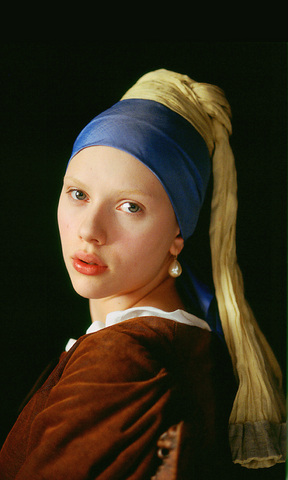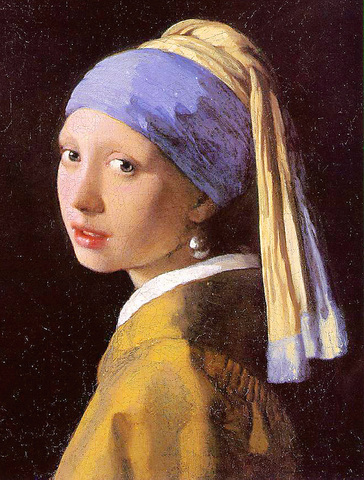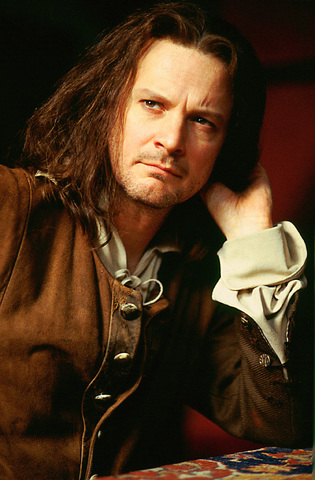At the beginning of Girl With a Pearl Earring, Griet (Scarlett Johansson) is shown peeling an onion, an image as metaphor rarely seen outside first-semester filmmaking classes. The determination visible in such an effort communicates Importance Writ Large. And the film, adapted by Olivia Hetreed from Tracy Chev-alier's novel, does have a great subject: the story surrounding an artwork shrouded in mystery and a project that ruins a woman's reputation yet ensures her a place in history.
This film is the imagined tale of Griet, a maid who became the muse of Johannes Vermeer and the subject of his painting Girl With a Pearl Earring. Johansson is photo-graphed so that her skin is as opalescent as her earring, but the movie is opaque. It is an earnest, obvious melodrama with no soul, filled with the longing silences that come after a sigh.
Yet the care that has gone into making Earring, a dexterous and absorbing visual re-creation of the lighting and the look that Vermeer achieved in his work, is a tribute to the director Peter Webber's own group of artisans, the cinema-tographer Eduardo Serra and the production designer Ben van Os. The gorgeous score, by Alexandre Desplat, brushes in a haunted gloom that gives the picture life where none seems to exist. This is the kind of film that would prompt the movie industry trade papers to say "technical credits above par."

PHOTO COURTESY OF CINEPLEX
The teenage Griet is sent off to earn a living because her blind father can no longer support her. The onion she is opening at the story's start is part of the last meal she prepares at home before being shipped off. Her separation anxiety registers so fully throughout the film that it should be listed in the cast of characters as the credits roll.
Anxiety permeates the movie like fear of punctures in a Freddy Krueger film. The household that Griet joins is filled with noisy, spoiled children who look down their noses at her. The mistress of the house, Catharina (Essie Davis), is about to add another mouth to the brood.
In addition to her other tasks, Griet is given the duty of cleaning the master's studio, where she develops an interest in the room and its contents. When she asks if she should clean the windows -- that would change the light, she notes -- a befuddled but indifferent mistress tells the maid to do so. Griet's attention to detail has caught the eye of the intense but distracted Vermeer, who is already behind on a commission that is keeping the family fed and clothed.

PHOTO COURTESY OF CINEPLEX
These commissions are brokered by Vermeer's imperiously practical, and equally proud, mother-in-law (Judy Parfitt), who suggests an art-house version of Frau Blucher from Young Frankenstein. The figures in his paintings seem to flinch when she speaks.
The jobs she secures for her son-in-law also keep Vermeer in the good graces of van Ruijven (Tom Wilkinson), an acquisitive and unabashed reprobate who also has an eye on Griet. "You have very wide eyes," he admires, turning a compliment into sexual harassment, and Wilkinson relishes every moment of aggression. His frankly projected appetites make him the only person in the film capable of enjoyment. He loves describing the press of fabric against a woman's skin as if he, too, were caressing it. And as the most fully realized character, he passes that pleasure along to the audience.
With all these assaults on her fluttering, tender sensibility -- and on her time -- it is no wonder that Griet always seems on the verge of tears. One of her few respites comes from the notice of the butcher's thoughtful apprentice, Pieter (Cillian Murphy). But she is far more intrigued by Vermeer, and based on Colin Firth's interpretation it is easy to see why. He plays Vermeer as a taciturn eccentric whose dark eyes house terror, anger and finally appreciation.

PHOTO COURTESY OF CINEPLEX
He drinks in Griet's understanding of his art. A scene in which he demonstrates the workings of a camera obscura to her -- and their transfixed faces are bathed in its buttery light -- has real emotional power; it is like watching a pair of kids trading secrets under a sheet. And when the painter does talk, he speaks faster and with greater passion than anyone else; words boil out of him. Though Griet drops her head in his presence, her shyness appears disingenuous; she may be the first person ever to be camera-obscura conscious.
Girl With a Pearl Earring is an auspicious feature-directing debut by Webber in so many ways -- a groaning board of temptations for the eye and ear -- that you may almost forgive the film its lack of drama and the perfunctory attempts at characterization. Viewing this film has been likened to watching paint dry; actually it is more like watching a painting dry.

“Why does Taiwan identity decline?”a group of researchers lead by University of Nevada political scientist Austin Wang (王宏恩) asked in a recent paper. After all, it is not difficult to explain the rise in Taiwanese identity after the early 1990s. But no model predicted its decline during the 2016-2018 period, they say. After testing various alternative explanations, Wang et al argue that the fall-off in Taiwanese identity during that period is related to voter hedging based on the performance of the Democratic Progressive Party (DPP). Since the DPP is perceived as the guardian of Taiwan identity, when it performs well,

The Taiwan People’s Party (TPP) on May 18 held a rally in Taichung to mark the anniversary of President William Lai’s (賴清德) inauguration on May 20. The title of the rally could be loosely translated to “May 18 recall fraudulent goods” (518退貨ㄌㄨㄚˋ!). Unlike in English, where the terms are the same, “recall” (退貨) in this context refers to product recalls due to damaged, defective or fraudulent merchandise, not the political recalls (罷免) currently dominating the headlines. I attended the rally to determine if the impression was correct that the TPP under party Chairman Huang Kuo-Chang (黃國昌) had little of a

At Computex 2025, Nvidia CEO Jensen Huang (黃仁勳) urged the government to subsidize AI. “All schools in Taiwan must integrate AI into their curricula,” he declared. A few months earlier, he said, “If I were a student today, I’d immediately start using tools like ChatGPT, Gemini Pro and Grok to learn, write and accelerate my thinking.” Huang sees the AI-bullet train leaving the station. And as one of its drivers, he’s worried about youth not getting on board — bad for their careers, and bad for his workforce. As a semiconductor supply-chain powerhouse and AI hub wannabe, Taiwan is seeing

Jade Mountain (玉山) — Taiwan’s highest peak — is the ultimate goal for those attempting a through-hike of the Mountains to Sea National Greenway (山海圳國家綠道), and that’s precisely where we’re headed in this final installment of a quartet of articles covering the Greenway. Picking up the trail at the Tsou tribal villages of Dabang and Tefuye, it’s worth stocking up on provisions before setting off, since — aside from the scant offerings available on the mountain’s Dongpu Lodge (東埔山莊) and Paiyun Lodge’s (排雲山莊) meal service — there’s nowhere to get food from here on out. TEFUYE HISTORIC TRAIL The journey recommences with